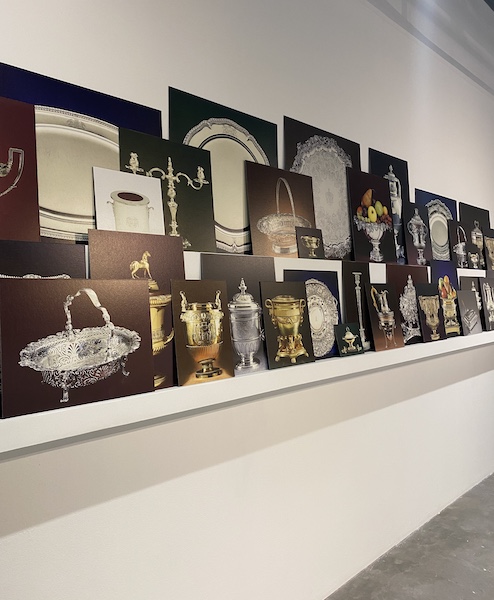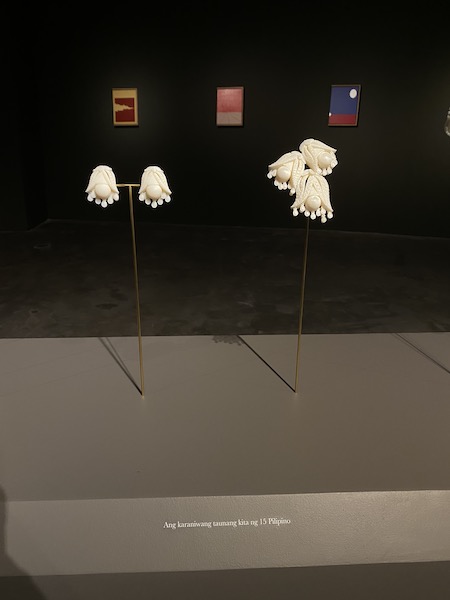Pio Abad's latest exhibit is a tireless exercise in truth-telling against Marcos disinformation
Most, if not all, artistic depictions of the Martial Law era tend to focus on the gruesome and gory aspects of the decades-long dictatorship.
Scenes of torture are ever-present and often play out in agonizing detail, whether in movies or museums. Understandably, these seek to evoke feelings of rage in viewers who may not have been around to witness this brutality firsthand, which probably explains the countless Dekada ‘70 viewings held in this generation’s history classes.
This makes Pio Abad’s current exhibit even more perplexing since, at first glance, it seems to aestheticize the darkest period our nation has faced. The collection of artworks that adorn the third floor of the Ateneo Art Gallery mirror a private showroom for elite patrons—or, even worse—a homage to our country’s “golden age” in culture and arts.
Thankfully, this act of seduction is deliberate. “It was a choice to focus on the aesthetics of this history and using these objects as a way of drawing the viewer into learning about the painful history contained within them,” Abad tells PhilSTAR Life in an email interview. “I present these objects not as cultural artifacts but as a body of evidence.” Hopefully, it’s what will get existing apologists of the Marcos regime to open their minds to these works: seeing that it’s not at all condescending or even explicitly angry, but merely an exercise in truth-telling.
It’s a sophisticated, sickening reminder of how this family’s insatiable greed continues to impede our national growth.
Entitled Fear of Freedom Makes Us See Ghosts, the London-educated artist’s masterwork is a culmination of a decade’s worth of curation and creation: one that takes root in his upbringing. As the son of student activists and community organizers, Abad’s interest in the preservation of our history is both encoded in his DNA and incorporated into his practice.
Unlike fallacious, unoriginal social media posts that are easily be fabricated, his carefully conceptualized body of work uses various mediums to prompt memory: from the traditional painting and sculpture to newer forms such as 3D printing and augmented reality.

The first installation of the exhibit centers on the disavowal and dissection of the myths the Marcoses tirelessly fought to keep in place. Seen in the gallery is a photo of the artist’s parents in Malacanang Palace, posing beside the infamous painting of the kleptocrat as Malakas: just one of many that comprise the ostentatious private collection he left behind when he fled for Hawaii.
If we recall, Ferdinand and Imelda had commissioned portraits of themselves as the first people of the Philippines in an attempt to reinforce their status as the leaders of a reformed republic. When news of Marcos’ controversial and unwarranted burial in the Libingan ng Mga Bayani broke out in 2016, Abad had these replicated only to paint them over in black—a metaphorical middle finger meant to defy their illusion of invincibility.

After exposing this initial layer of secrets, Abad then grants the viewer a glimpse into the sheer scale of their deceit.
Named after the false identities used to deposit hundreds and thousands of dollars into Swiss bank accounts, The Collection of Jane Ryan and William Saunders displays the couple’s sequestered collection of multi-million dollar artifacts in photographs, framed drawings, and postcards—which visitors are encouraged to keep. This simple act is the closest taxpayers can get to reclaim the works of art that they inadvertently paid for.
An entire room is also devoted to resin reconstructions of just some of Imelda’s jewelry, each piece displayed alongside a vivid picture of their true cost. A pair of earrings, for instance, is tantamount to the annual income of 15 Filipinos, while a single necklace can power around 2,200 homes in off-grid areas. It’s a sophisticated, sickening reminder of how this family’s insatiable greed continues to impede our national growth.

The showcase culminates in a memorial for those who fought to topple the oppressive Marcos regime, sometimes even at the cost of their own lives.
While many would cower in intimidation, the artist sees this as a greater reason to soldier on.
Abad takes the covers of Marcos’ propagandistic materials and reduces them to form and color: mere symbols of the New Society that never came to be. These “productive forms of grieving what we have lost”, as he calls them, serve as tributes to those at the forefront of resistance: community organizers, politicians, and student activists.
Bringing his work back to the university where his parents once sought campus arrest, during the last leg of campaign season is undoubtedly risky. The Marcoses are determined to pull off the most devastating comeback our country has seen. To make matters worse, their efforts are fortified by a complex ecosystem of disinformation, where participants are literally paid to revise entire chapters of our well-documented history.
When asked about how his work has been received by the supporters he wants to convert, Abad reveals that “[their] main comments on social media mostly ask where is the evidence, when I have researched extensively and presented the evidence I already have in clear and very visually rich terms that it’s rendered incontrovertible.”
But while many would cower in intimidation, the artist sees this as a greater reason to soldier on.
“Artists persist and even thrive under the most difficult circumstances. Our current collective efforts to shed light on the dark history of the Marcoses and to resist attempts to erase this history will and should continue beyond this elections,” Abad warns. “Art is an important way to bear witness and the explosion of creativity and civic passion that we have witnessed recently is a testament that is shared by many.”
Now more than ever, Fear of Freedom Makes Us See Ghosts calls us to apply our creative liberties in pursuit of the truth: to preserve and propagate real narratives before they are erased in favor of a problematic legacy, to spot and stop distortions from creating further damage. If we fail to do this before it’s too late, our very freedom to fight may soon be stripped away.
Pio Abad: Fear of Freedom Makes Us See Ghosts will run at the Ateneo Art Gallery until July 30, 2022. Visits are strictly by appointment and can be scheduled through bit.ly/VisitAAG.


